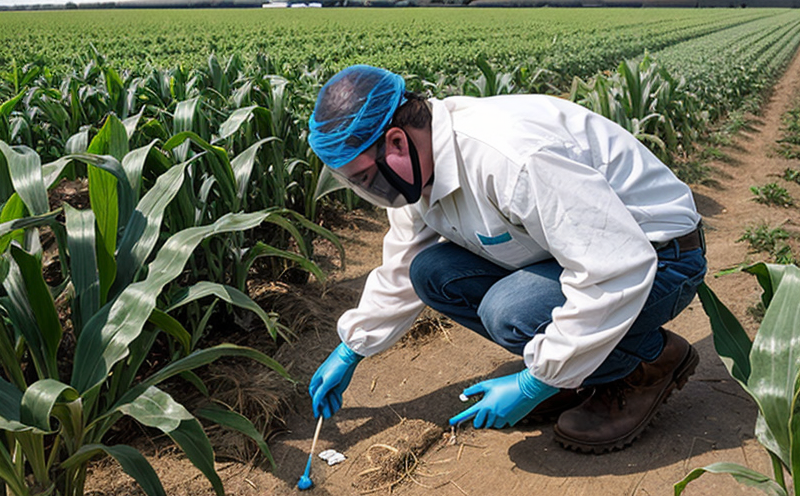Dicamba Residue Testing in Crops
The presence of dicamba residues in crops has become a critical concern in agricultural and forestry testing. Dicamba is a potent herbicide used to control broadleaf weeds, but its widespread use can lead to off-target drift or overapplication, resulting in contamination of edible crops. This contamination poses significant risks not only to human health but also to the environment.
Our laboratory provides comprehensive Dicamba Residue Testing services for various crops, ensuring that products meet strict regulatory standards and consumer expectations. We offer testing on a wide range of agricultural commodities including grains, fruits, vegetables, and specialty crops. The demand for this service is growing due to increasing concerns about food safety, environmental protection, and compliance with international regulations.
Accurate and reliable dicamba residue testing is essential for maintaining the integrity of the supply chain. From raw material procurement to final product distribution, our laboratory supports stakeholders across the entire agricultural sector by providing robust quality assurance measures. Our services cater specifically to those involved in crop production, food processing industries, regulatory bodies, and research institutions.
Our team employs state-of-the-art analytical techniques that are capable of detecting even trace levels of dicamba residues. These methods include gas chromatography-mass spectrometry (GC-MS) and liquid chromatography-tandem mass spectrometry (LC-MS/MS), which ensure high sensitivity and specificity in identifying dicamba and its metabolites.
The importance of dicamba residue testing cannot be overstated, especially given the potential health impacts associated with overexposure. Regulatory agencies worldwide are implementing stricter limits on acceptable levels of dicamba residues in food products to protect public health. By offering this specialized service, our laboratory helps clients stay compliant with these regulations and enhance their reputation for producing safe and high-quality agricultural produce.
Our approach to dicamba residue testing includes several key steps: sample collection, preparation, analysis, and reporting. Sample collection is critical; it must be representative of the entire batch or field area being tested. Proper sample preparation ensures accurate results by minimizing contamination and maximizing recovery rates. Our laboratory uses standardized procedures recommended by international standards such as ISO 18564.
The analytical process involves thorough extraction methods tailored to individual crop types, followed by rigorous purification steps if necessary. Once purified, the samples undergo precise quantification using advanced mass spectrometry instruments. This meticulous attention to detail guarantees reliable detection and measurement of dicamba residues at parts-per-billion (ppb) levels.
Reporting is an integral part of our dicamba residue testing service. Clients receive detailed reports that include raw data, calculated concentrations, comparison against regulatory limits, and recommendations for further action if necessary. These insights enable stakeholders to make informed decisions regarding their operations and products.
Applied Standards
| Standard | Description |
|---|---|
| ISO 18564:2019 | Determination of dicamba in food and feed by gas chromatography-mass spectrometry (GC-MS) |
| ASTM E2739-14 | Standard test method for the determination of dicamba in water by liquid chromatography-tandem mass spectrometry (LC-MS/MS) |
| IUPAC Recommendations | Procedures for sample preparation and instrumental analysis |
The testing procedures comply with the latest international standards, ensuring accuracy and consistency. The selected methods are validated according to ISO 18564:2019 and ASTM E2739-14, which provide robust guidelines for detecting dicamba residues in diverse matrices.
Our laboratory adheres strictly to these standards throughout the entire testing process, from sample preparation to final reporting. This commitment ensures that our clients receive dependable results that meet both local and international regulatory requirements.
Scope and Methodology
The scope of dicamba residue testing encompasses a broad range of agricultural commodities, reflecting the diverse nature of crop production practices. Our laboratory accepts samples from various sources including farms, processing plants, and wholesale markets. We analyze these samples to determine whether they contain unacceptable levels of dicamba residues.
Methodology plays a crucial role in achieving accurate results. Each step—from initial contact with clients to delivery of final reports—follows predefined protocols designed to minimize errors and maximize precision. Our team adheres rigorously to these procedures, employing best practices recommended by recognized bodies like the International Organization for Standardization (ISO).
For instance, when testing grains like wheat or corn, we account for potential variations in moisture content and other physical characteristics that could affect extraction efficiency. In fruits and vegetables, special care is taken during sample preparation to avoid mechanical damage which might lead to false positives.
The analytical process itself involves several stages: first comes the initial screening using immunoassay technology, followed by confirmation via GC-MS or LC-MS/MS if positive findings are detected. This dual approach ensures both rapid detection and definitive identification of dicamba residues.
Once identified, quantification proceeds with utmost accuracy to provide precise concentration values. These measurements play a vital role in determining whether the crop meets established safety thresholds set by relevant authorities.
Eurolab Advantages
At Eurolab, we pride ourselves on delivering exceptional dicamba residue testing services that go beyond mere compliance. Our advanced facilities and experienced professionals ensure accurate results every time, regardless of the complexity or volume of your samples.
Our laboratory is equipped with cutting-edge equipment capable of handling even the most challenging samples. From high-performance liquid chromatographs to sophisticated mass spectrometers, our instrumentation supports precise analyses at parts-per-billion sensitivity levels.
We employ highly trained and certified analysts who stay updated on the latest developments in dicamba residue testing methodologies. Their expertise allows us to interpret results accurately and provide actionable recommendations tailored to your specific needs.
Moreover, our commitment extends beyond just providing test data; we also offer comprehensive support services including training sessions for personnel involved in collecting samples or interpreting results. This holistic approach ensures that all aspects of dicamba residue testing are addressed comprehensively.
In addition to technical excellence, Eurolab stands out through its unwavering dedication to sustainability and ethical business practices. We strive to minimize waste generation during our operations while adhering strictly to environmental protection regulations. By choosing us as your partner in dicamba residue testing, you contribute positively towards maintaining a sustainable agricultural industry.





